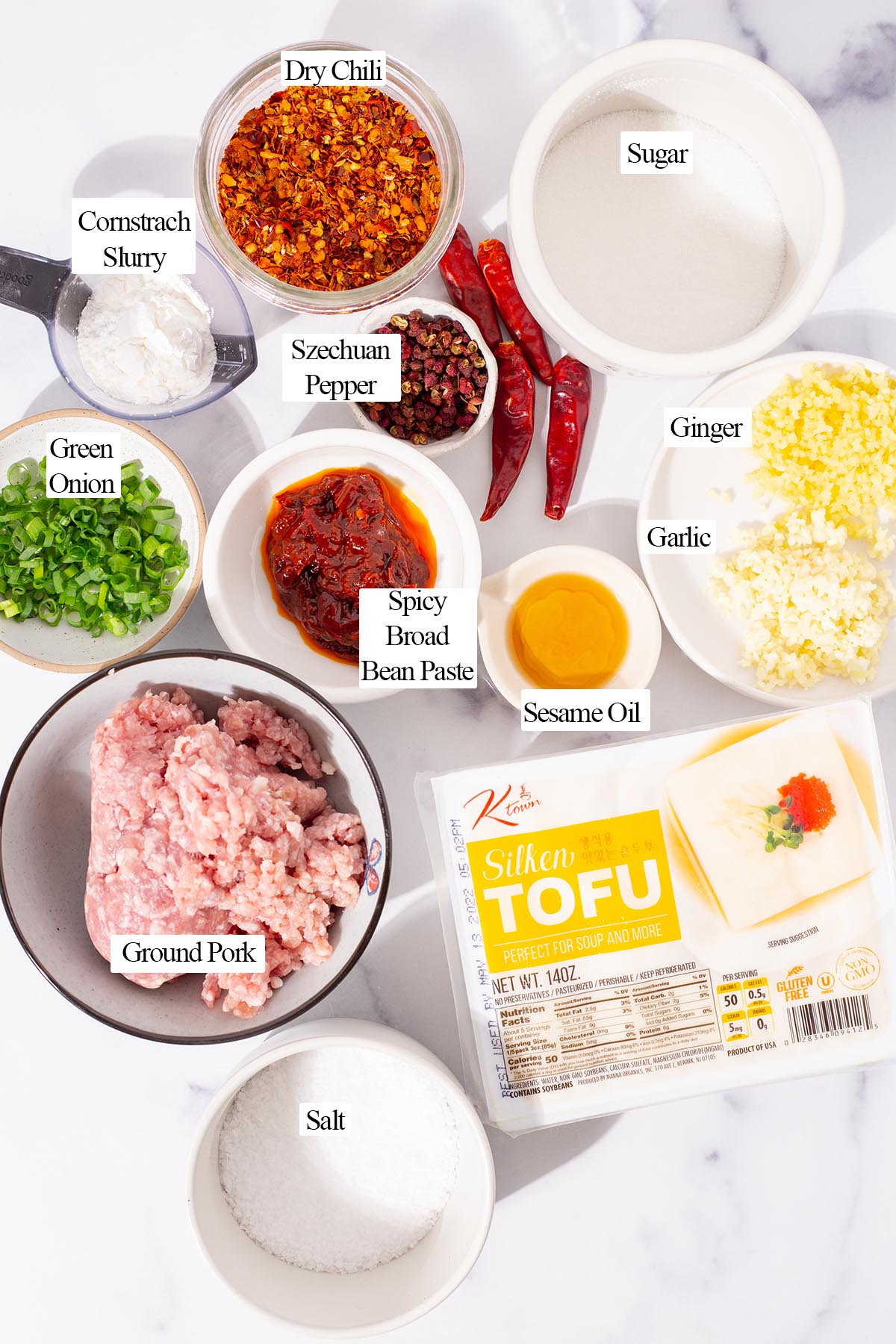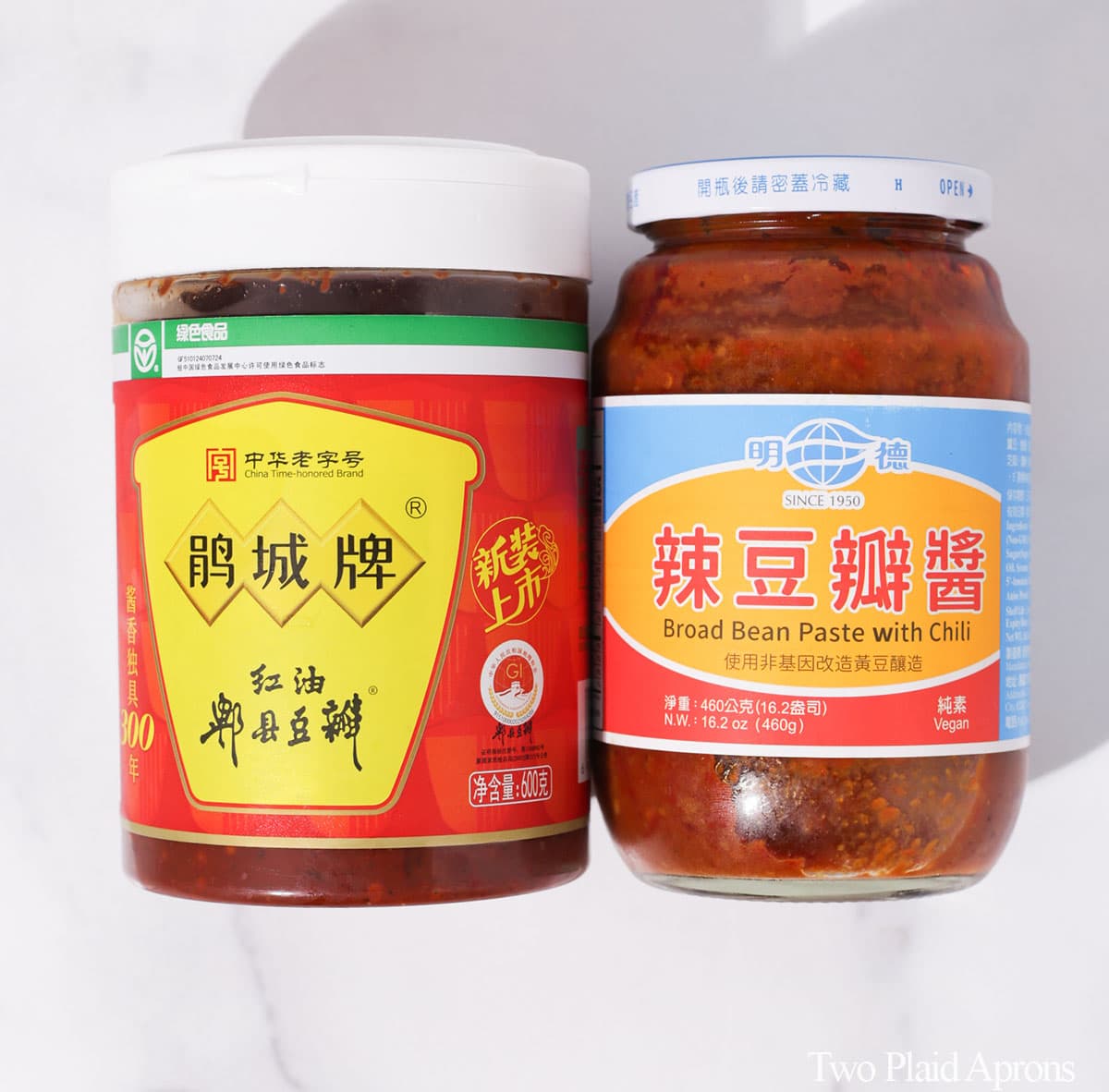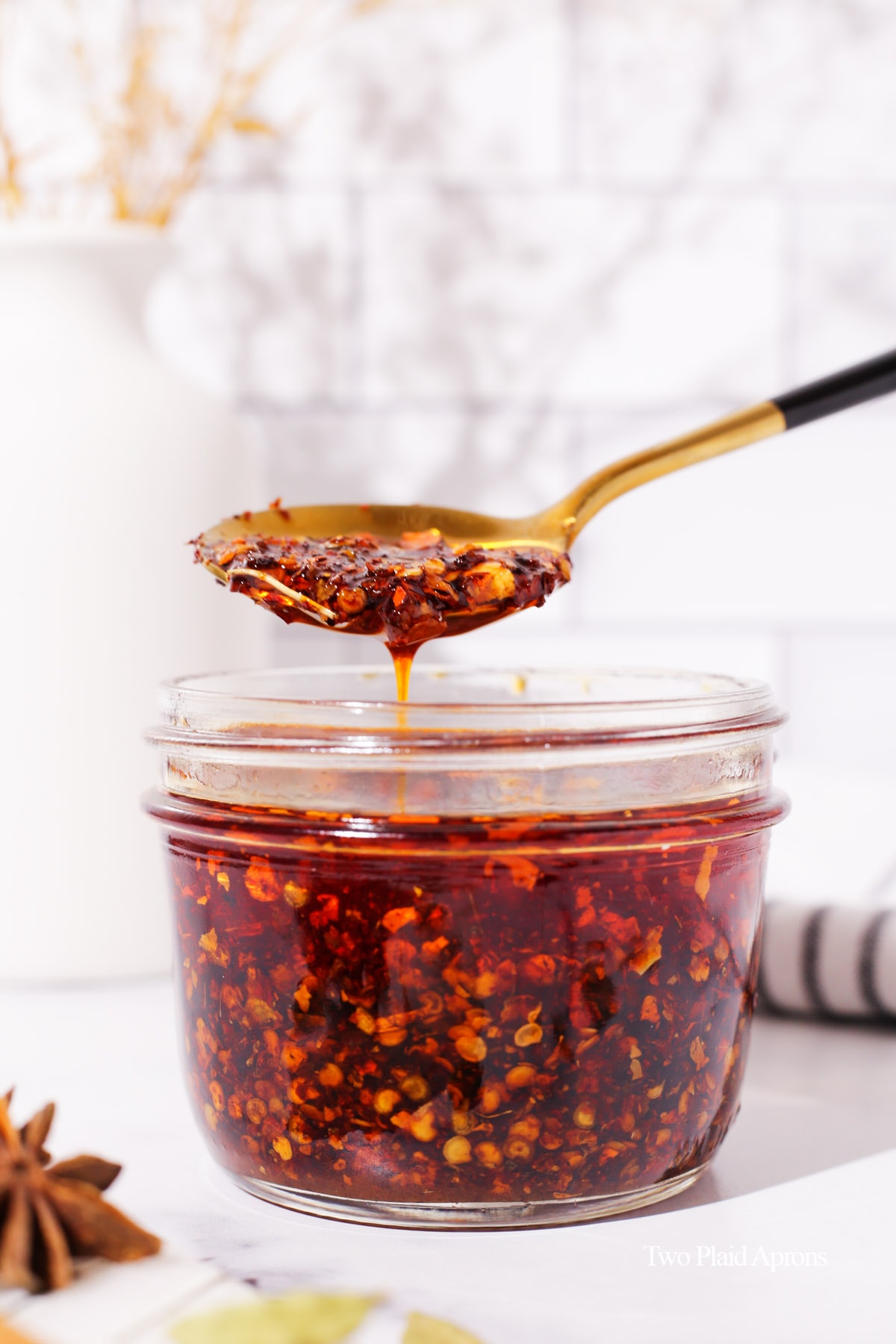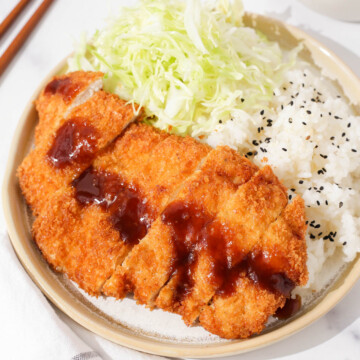Mapo tofu is a popular Chinese tofu dish from the Sichuan Province. It's fragrant, savory, numbing, and addictively spicy! This spicy tofu dish takes less than 30 minutes to make and is incredible over rice or as a side dish. Our version has been adapted so that it's mild to medium in spiciness.

Mapo tofu is one of our favorite Sichuan dishes, and it's so easy and simple to make at home! Our version is adapted to be mild to medium in spiciness because both Kyong and I can't handle overly spicy dishes. But we promise it tastes just as good as the extra spicy ones!
If you liked this recipe, you may also like our other Chinese recipes like air fryer crispy pork belly, red braised pork, Taiwanese fried chicken, and simple egg fried rice!
Also try our Korean fresh strawberry milk! It's the perfect pairing for cooling down the heat!
Jump to:
What is mapo tofu?
Mapo tofu in Chinese is called má pó dòu fu (麻婆豆腐) and literally translates to "pockmarked grandma's tofu." It's a very popular Chinese dish from the province of Sichuan.
You've probably seen this spicy tofu dish listed on most Chinese restaurant's menu, and most likely, each establishment have their own variation. Depending on who's making this dish, it can vary in levels of spiciness, numbness, and sometimes even with the addition of ingredients that's not traditionally in mapo tofu. Nevertheless, each tastes good in their own way and caters to a different palette.

What does mapo tofu taste like?
A good classic mapo tofu is known for its fragrant aroma, additive numbness, reddish color, and heat, both in spiciness and temperature.
We created our recipe with moderate spiciness in mind, as neither of us can handle a lot of heat. BUT don't worry! It is still fragrant, savory, reddish in color, slightly numbing, and with medium level spiciness. If you enjoy that extra heat, you can adjust it to your preference by adding more dry chilies or adding spicy fresh chilies, like bird's eye chili.
Ingredients
Please scroll down to the recipe card for ingredient quantity!
- Tofu - Silken tofu is the most popular choice of tofu because it gives the dish that silky, smooth texture. But honestly, this is all personal preference. Some chefs even prefer firm and extra firm tofu. Each tofu has its own pro's and con's, so experiment and find what you prefer!
- Ground pork - Either ground pork or ground beef can be used. Whichever one you use, try to get ones with a bit of fat. 70% to 30% is preferred. If the ground meat is too lean, it tends to become dry, which is not the best mouthfeel.
- Sichuan peppercorn - We recommend grinding the Sichuan peppercorns so that you don't get a surprise, numbing explosion.
- Chinese dry chili - You can use either whole Chinese dry chilies and grind it yourself or the Chinese dry chili powder.
- Fresh ginger and garlic - To make it extra fragrant and flavorful!
- Spicy broad bean paste - Also known as la doubanjian (辣豆瓣酱). Each brand varies in flavor, but we highly recommend using brands labelled with "Pixian" (郫县) for the most authentic flavors.
- Water or stock - You can use either water or stock. But since we are already using ground pork, we opted for just water to naturally make a broth.
- Sugar - Just a little bit of sugar goes a long way. It helps round out and help balance all the flavors.
- Chicken stock powder - This is optional, but one of our absolute favorite seasonings. It's a form of MSG, but really adds that extra bit of "oomph" a dish needs. Chicken stock powder also subs for chicken stock and is very similar to chicken bouillon.
- Cornstarch slurry - It's for thickening the mapo tofu sauce. Just mix the cornstarch with cold water until combined and give it a mix before using.
- Sesame oil and green onions (optional) - For color and flavor. If you prefer, cilantro is a great add-on or substitute for the green onions.
- Oil (for cooking)
- Salt - For blanching the tofu.

Use the right bean paste!
I know Chinese condiments can be quite confusing, cuz there's like a dozen bean pastes variations! The one you need for mapo tofu is spicy broad bean paste or là dòu bàn jiàng (辣豆瓣酱), preferably one labeled with "Pixian" (郫县), meaning it's from the Pi Couty.
La doubanjiang is made with fermented broad beans with chili oil, and it's THE base flavoring of mapo tofu. We recommend that you use a la doubanjiang labeled with "Pixian" because those bean pastes tastes the most authentic and flavorful, as it's from a county within the Sichuan Province, aka where mapo tofu originated.

What tofu to use
Although silken tofu is the most popular choice of tofu a lot of Chinese restaurants use for mapo tofu, this is really all up to personal preference. Each tofu's firmness have its own pros and cons.
If you prefer silky smooth texture, you may like silken tofu. But silken tofu tends to be quite fragile and doesn't absorb flavors as fast. On the other hand, firm and extra firm tofu has coarser texture, but they are like sponges because they are more porous. They're also less prone to breaking when handling. So experiment and find which tofu you prefer using!
Make it spicer
You can easily adjust the spice level for this mapo tofu recipe by using more ground dry chili peppers or fresh hot peppers like bird eye chilis. Adding more pepper and using fresh red peppers will also make your mapo tofu brighter and redder!
If you are adding fresh chili peppers, just chop it up or slice them and stir fry them with the rest of the dry chili peppers and Sichuan peppers.

How to make mapo tofu
Mapo tofu is actually super easy to make and takes less than 30 minutes! So follow along and start making mapo tofu, better than your Chinese take-outs!
Purge the tofu:
1. Drain the liquid from the tofu package and place the tofu onto a cutting board. As evenly as possible, cut the tofu into cubes, about ½ inch to 1 inch thick.
2. In a pot, add the salt and enough water to cover the tofu. Gently, place the cubed tofu into the pot and heat it over medium heat until the water starts to boil and bubble. *We recommend about 1 teaspoon of salt per 6 cups of water.*
3. Once the water is nearly at a boil, drain the tofu completely and set aside until needed.

Make the mapo tofu:
1. In a small pot, add the cooking oil and heat over medium low heat. Once the oil is hot, add the ground dry chili pepper and Sichuan pepper and stir fry for 15 to 30 seconds, until the peppers are toasted.
🌟 Pro tip: If you're using a wok, make sure to make it "nonstick" first! First, heat up the wok on high heat until it's smoking. Then, add a high smoking point cooking oil and swirl it all around the wok while heating. Pour out the excess oil before use. If you are stir frying something that needs to be cooked on a lower heat like the dry chilis, let the wok cool a bit before using so the peppers don't burn!
📝 Note: If you want your mapo tofu spicier, you can use more dry chili pepper powder or add fresh hot chilis like bird's eye chili. Just chop up the fresh chilis and stir fry it along with the dry chili peppers.
2. Once the chilis and peppers have been toasted, add the ground pork and stir fry until they are no longer pink and starts to brown, about 3 to 5 minutes. The fats will also be rendering at this point.
3. Add the minced ginger, garlic, and la doubanjiang (spicy broad bean paste), and stir fry until the ginger and garlic is fragrant and everything is well combined, about 1 to 2 minutes.

4. Add the water or stock and tofu. Increase the heat to medium high and bring it to a boil. While waiting, season the mapo tofu with sugar and chicken stock powder. Once the mapo tofu comes to a boil, reduce the heat to keep it at a gentle simmer, for about 3 to 5 minutes. Stir occasionally.
🌟 Pro tip: Because tofu is so tender and fragile, we recommend a shaking stirring motion. Just gently shake the pot back and forth while pushing gently with the back of the cooking spoon/ladle, starting from one edge of the pot. If you need a visual reference, please check out our short video on our Instagram page!
5. After simmering, taste the mapo tofu's sauce and season with salt or dilute with a little water if necessary. This depending on the brand of la doubanjiang you use and personal preference.
6. Give the cornstarch slurry a mix, then drizzle it into the mapo tofu in three sessions. Between each addition, make sure to gently stir the mapo tofu and wait for it to slightly thicken before the next addition.
📝 Note: You could drizzle in all of the cornstarch slurry at one time if you prefer, but we find adding it in multiple sessions, keep the mapo tofu sauce thick and glossy longer.
7. After the last addition of cornstarch slurry, add the sesame oil and sliced green onion. Give everything a gentle stir and transfer to your serving bowl. Garnish with more green onions and a bit of ground Sichuan peppercorn if you like. Enjoy while hot!

Why do I need to cook the tofu in water first?
The blanching process in the beginning is to purge the tofu of that strong soybean smell, help firm up the tofu, and to get rid of excess water in the tofu.
You probably think boiling the tofu to get rid of excess water is redundant, but it really does draw out extra moisture from the tofu. It's most noticeable in firmer tofus. Getting rid of excess water will prevent your mapo tofu sauce from getting diluted and thinned out.
Recipe tips
- Not all la doubanjiang are made equally! Depending on which brand you use, the flavor may differ. We highly recommend using spicy broad bean paste labeled with "Pixian" (郫县) for the best, most authentic flavors.
- Add more dry chili or fresh hot chili if you prefer your mapo tofu spicer. You can easily adjust the spice level by either using more dry chili or add some hot chilis like bird's eye chili.
- Adding more peppers and chili will give you brighter, redder mapo tofu. The vibrant red in classic mapo tofu is from stir frying Chinese dry chilis and fresh hot red peppers in oil.
- Adjust the saltiness and thickness of your mapo tofu to your personal preference. The saltiness is dependent on the brand of la doubanjiang you use and how long you simmer the mapo tofu for. The thickness can be adjusted by how much cornstarch slurry you add.

What to eat with mapo tofu
Our favorite way to enjoy mapo tofu is with some hot steamed white rice. Or better yet, over rice! Mapo tofu is also super yummy with noodles like udon, sweet potato vermicelli (the same noodles used for japchae), and hand-pulled noodles!
We'd often eat our leftover hand-pulled biang biang noodles with mapo tofu, and it is so good! If you like veggies, we recommend some blanched baby bok choi. Sometimes when we want to add some extra flavor, we use a couple drizzle of our homemade Chinese chili oil. That stuff is like liquid gold!

Storage
If you have leftover mapo tofu, transfer it to an airtight container and let it cool completely before refrigerating. It'll stay good in the fridge for up to 5 to 7 days.
Reheating
You can reheat leftover mapo tofu on the stovetop or in the microwave. Do note that the sauce will be looser once it cools down, so make sure to heat it until it bubbles. And if needed be, add a little more slurry to the mapo tofu to thicken the sauce.

FAQ
Although most Chinese restaurant uses silken or soft tofu to make their mapo tofu, it's really all up to personal preference. Each type of tofu have its own pros and cons.
Traditionally, mapo tofu is made with ground beef or ground pork. The ground meat really adds a lot of flavor to the dish and creates a natural "broth" to simmer the tofu in.
Unfortunately, our mapo tofu recipe is not gluten free because most la doubanjiang (spicy broad bean paste) contains wheat. However, if you're able to find a brand without gluten, you can make gluten free mapo tofu! The great news is that, mapo tofu is nut free (as long the brands you chose is nut free)!
If you’ve made this recipe or any recipes from our blog, please tag us on Instagram using #twoplaidaprons! You can also tag us in your Instagram stories using @two_plaid_aprons. We would love to see your creations! It absolutely makes our day! 🥰
📖 Recipe
Mapo Tofu
Ingredients
- 16 ounces silken tofu or soft tofu (Depending on the brand, the weight will be different. Anything between 14 and 18 ounces is fine.)
- 3 tablespoons oil or as much as needed
- 1 teaspoon Chinese chili pepper flakes more or less to your spice preference (preferably powdered)
- ½ teaspoon Sichuan peppercorn grounded (more or less to your preference)
- 8 ounces ground pork or ground beef
- 2 tablespoons ginger minced (about a 2 inch knob)
- 2 tablespoons garlic minced (about 3 to 4 cloves)
- 1½ tablespoons spicy broad bean paste (also known as spicy doubanjiang)
- 1½ cups water or stock
- 1 teaspoon granulated sugar
- 1 teaspoon chicken bouillon powder (optional)
- 3 tablespoons cornstarch (mixed with 3 tablespoons cold water)
- 2 teaspoon toasted sesame oil (optional)
- 1 stalk green onion thinly sliced (optional)
- Kosher salt or fine salt (for blanching the tofu)
Instructions
Purge the tofu:
- Remove the tofu from its container and drain the liquid. Cut the tofu into equal size cube, as best as possible, about ½ to 1 inch thick.
- Fill a small pot with enough water to submerge the tofu. Gently place the cubed tofu into the water and add some salt.*We recommend about 1 teaspoon of salt per 6 cups of water.*
- Place the pot on medium heat. Gently stir it occasionally while the water is heating up. Once the water starts to simmer and bubble, drain the tofu and set it aside.
Make the mapo tofu:
- In a small pot, add the oil and heat it over medium low heat. Once the oil is hot, add the dry chili peppers and ground Sichuan peppercorn. Stir fry the peppers in the oil for about 15 to 30 seconds or until toasted.
- Add the ground pork and cook until no longer pink and the fat starts to render, about 3 to 5 minutes. Make sure to stir and break up the ground pork to cook evenly.
- To the ground pork, add the minced ginger, minced garlic, and spicy broad bean paste. Cook until everything is fragrant and well combined.
- Add the water or stock and the purged tofu. Then, increase the heat to medium high to bring it to a boil. While waiting on the sauce to come to a boil, add the sugar and chicken stock powder. Once it comes to a boil, reduce the heat so that it's at a gentle simmer. Let the mapo tofu simmer for 3 to 5 minutes depending on how salty you like it. Make sure to occasionally stir the mapo tofu while it's simmering.*After simmering, you can taste the mapo tofu sauce to see if it needs a little more salt or if it needs to be slightly diluted with water.*
- While waiting on the mapo tofu, combine the cornstarch with the water to make a slurry. After the mapo tofu is done simmering, give the cornstarch slurry a mix and drizzle it into the mapo tofu in three sessions. Make sure to stir the mapo tofu between each addition and wait for it to thicken before the next addition.*You can also add the cornstarch slurry all at once, but we find the mapo tofu to thicken better and stay thickened longer when adding the slurry in separate sessions.*
- Once the slurry has been added and the mapo tofu has thickened, add the sesame oil and green onion. Give it a few gently stirs to combine and transfer the mapo tofu to a serving bowl.
- Garnish the mapo tofu with more green onions and a bit of ground Sichuan peppercorn if you want. Enjoy with rice while hot!
Notes
- Spicy broad bean paste - Depending on the brand, the flavor and saltiness can be totally different. For the most authentic taste, we recommend using a brand labeled "Pixian" la doubanjiang. It will mostly be saltier than other brands, but a little goes a long way!
- Tofu - You'd most often see mapo tofu made with silken tofu, but it's really up to personal preference. So try it out with soft, medium, and firm tofu as well to find out what you prefer. We like to use soft tofu when we can't find silken tofu.
- Gently stir the mapo tofu. Because tofu is so fragile, we recommend stirring the mapo tofu by shaking the pot while pushing the tofu with the back of the spoon. If you want a visual reference, you can check out our short video on Instagram and YouTube.






















Comments
No Comments